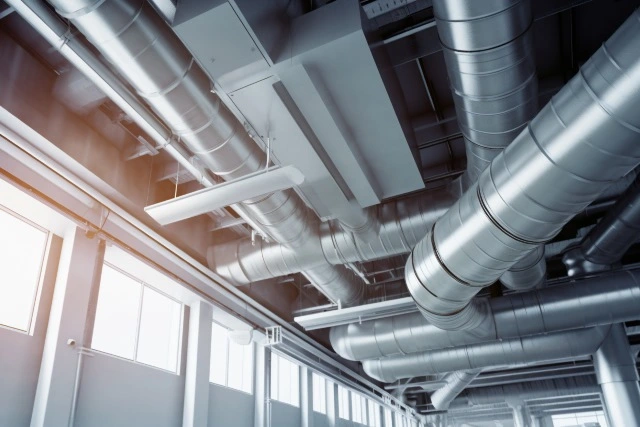HVAC systems are notorious energy consumers, accounting for a significant portion of a building’s energy usage. Traditional ventilation systems often operate at fixed rates, regardless of actual demand, leading to excessive energy waste. Demand controlled ventilation introduces a more intelligent approach by dynamically adjusting ventilation rates based on real-time demand.
What does ‘demand controlled ventilation’ mean?
Demand controlled ventilation (DCV) offers a way to ventilate indoor spaces based on the current needs of the indoor space. It adjusts ventilation based on two key factors: occupancy and air quality. As a room’s occupancy and air quality vary, DCV systems automatically adjust to reduce energy use while keeping occupants comfortable.
Tailoring ventilation based on occupancy and air quality
Occupancy and air quality determine the need for ventilation. DCV systems lower the ventilation rate in unoccupied or semi-occupied rooms and raise the ventilation rate in occupied rooms. These systems use occupancy sensors to determine the occupancy of a space.
DCV systems use sensors that monitor temperature, humidity, and pollutants in the air to adjust based on air quality. Those pollutants can include CO2 (carbon dioxide), VOC (volatile organic compounds), and PM (particulate matter). If the air quality falls below a certain threshold, demand-controlled ventilation automatically boosts the airflow to improve circulation and create a healthier indoor environment. Most building management systems can integrate DCV controls, allowing you to set the occupancy and air quality thresholds.
When and where is it required?
While a DCV system offers benefits for any indoor space, it shines in a few key scenarios, including:
- Commercial buildings: DCV is crucial in busy offices, retail spaces, and restaurants to ensure fresh air and comfort during peak occupancy without wasting energy.
- Educational institutions: Schools and universities benefit from demand-controlled ventilation as it adapts to the changing occupancy levels during classes.
- Healthcare facilities: Hospitals and clinics rely on DCV to maintain clean and safe environments, promoting better air quality and minimizing the risk of infections.
- Housing complexes: Residential complexes can customize ventilation to meet the needs of different preferences and occupancies within a multi-family building.
Difference between DCV systems and heat recovery
While both DCV and heat recovery systems aim to reduce energy consumption without impacting the occupant experience, they achieve this result differently. DCV adjusts ventilation based on occupancy and air quality, ensuring fresh air while saving energy. Heat recovery captures and reuses heat from outgoing air to reduce heating and cooling needs, making buildings more energy-efficient.
How does this method save energy?
Traditional ventilation systems always run at the same speed, even when few or no people are around. This wastes energy as it requires an individual to adjust the ventilation, which rarely happens manually.
Demand controlled ventilation adjusts the airflow based on how many people are in the room. It uses sensors to figure out the occupancy levels. When there are fewer people, it lowers the ventilation. This saves a lot of energy because it provides fresh air when a space needs it.
What is the most efficient way to conserve energy in HVAC systems?
Beyond DCV and heat recovery systems, regular maintenance and cleaning can improve the operational efficiency of any HVAC system. This includes cleaning and tuning filters, coils, and fans, sealing air leaks, and installing proper insulation. You can also use programmable thermostats with a low, upfront investment to reduce energy use.
Demand controlled ventilation in the context of facility management
With DCV, facility managers can deliver the right amount of fresh air when and where needed, reducing energy waste. It automates this process to reduce the workload on facility managers as well.
Enhancing HVAC system efficiency and performance
During busy periods, DCV increases ventilation to meet the higher demand for fresh air. During quieter times, it reduces ventilation to conserve energy. This adaptability ensures occupant comfort and significant energy savings, benefiting facility managers in multiple ways.
Importance of DCV for achieving building certifications
DCV also contributes to achieving building certifications and meeting sustainability goals. Achieving BREEAM certification or acquiring a LEED certificate requires efficient ventilation to promote indoor air quality. By implementing a DCV system, facilities can more easily meet certification requirements.
Benefits of using demand-based ventilation control in CRE buildings
Here are four key benefits of demand-based ventilation control in CRE buildings:
- Energy savings: Adjusting airflow based on real-time occupancy reduces energy waste and costs.
- Improved indoor air quality: Tailoring ventilation to air quality creates a healthier indoor environment.
- Enhanced comfort and productivity: Occupants experience increased comfort and productivity in a properly ventilated space.
- Promote sustainability: Demand-based control supports sustainability goals by reducing energy consumption and promoting responsible building management.
Proptech automation
With Proptech automation, building managers and owners can enhance the capabilities of their DCV systems by interconnecting them with other building systems. This allows different facility systems to work together, further improving building efficiency.
For example, connecting demand-controlled ventilation technology with thermal mass information can further optimize an HVAC system. Giving a DCV system thermal mass information allows it to consider the thermal mass of building spaces when activating and deactivating ventilation systems. It can also use thermal mass to incorporate heating and cooling into the ventilation for a more consistent temperature.
